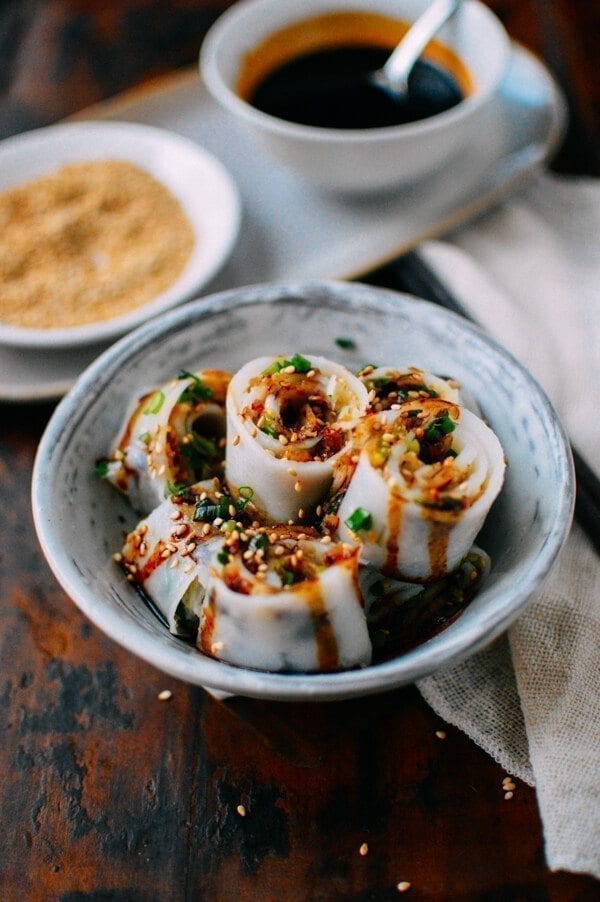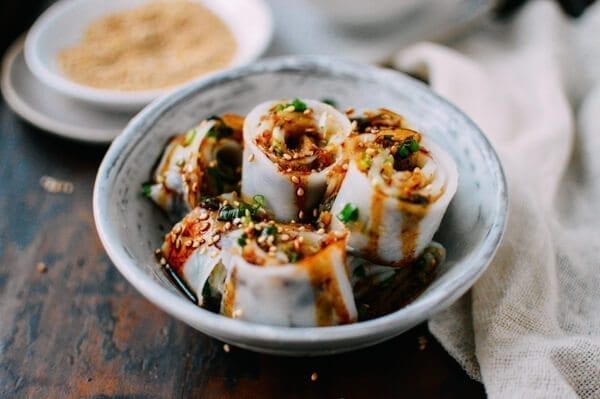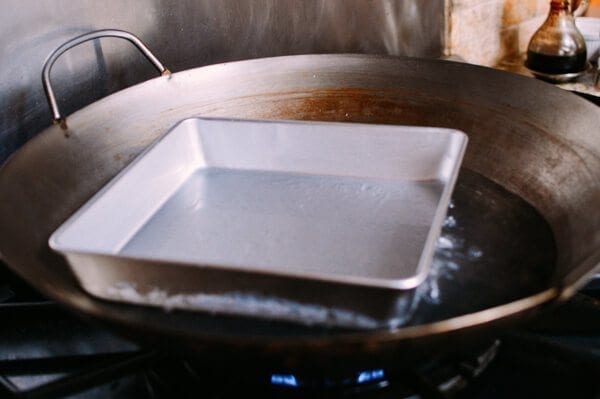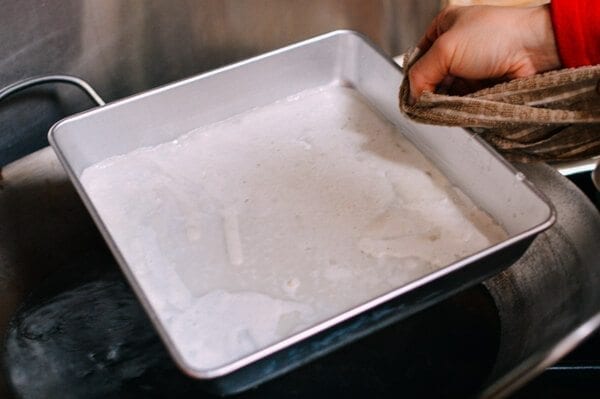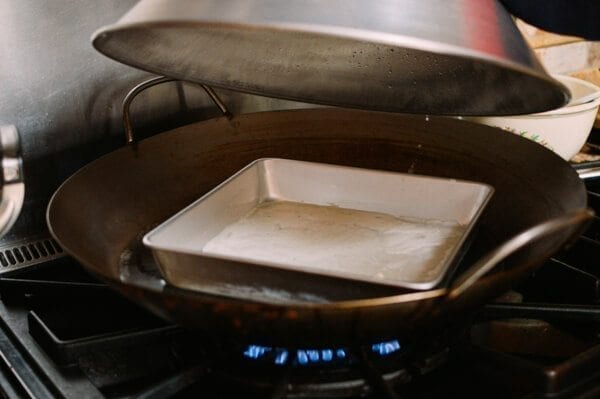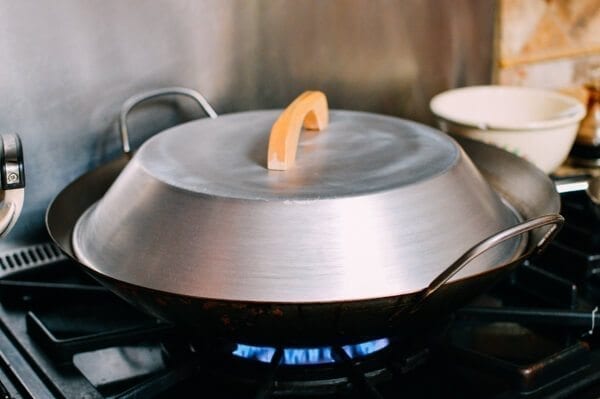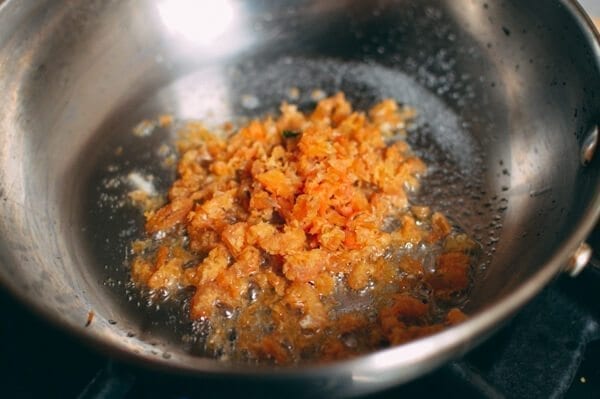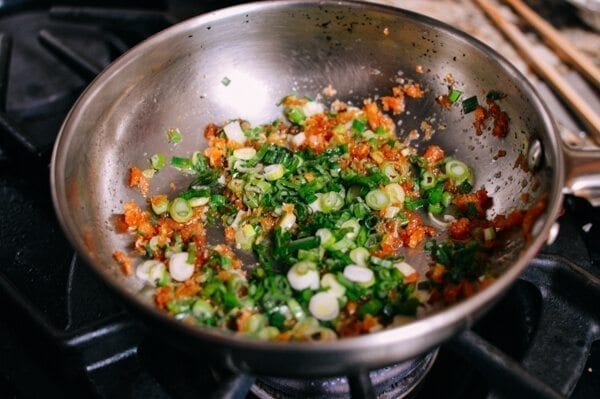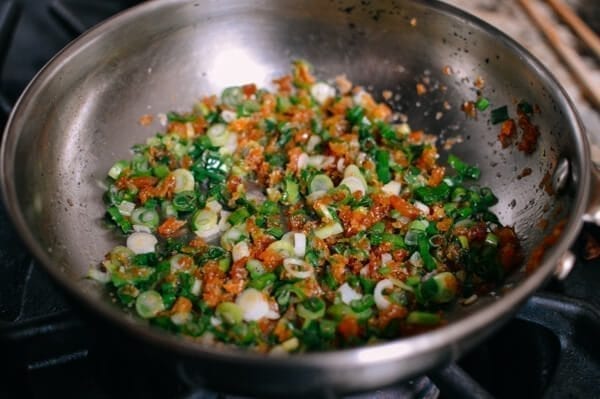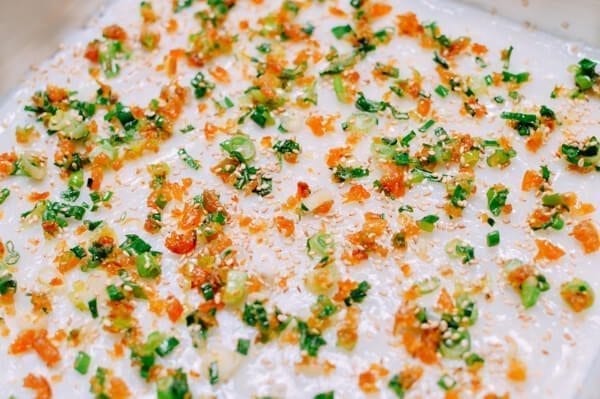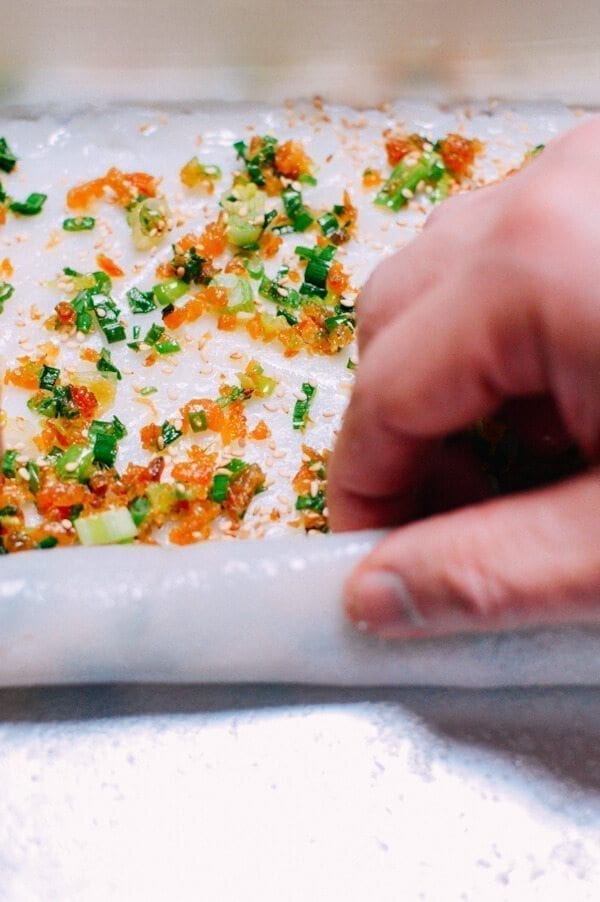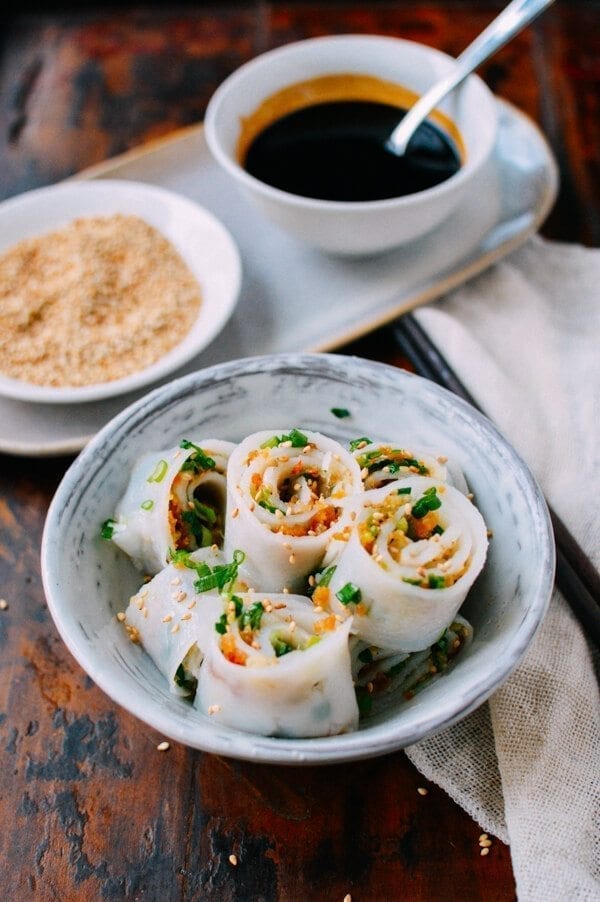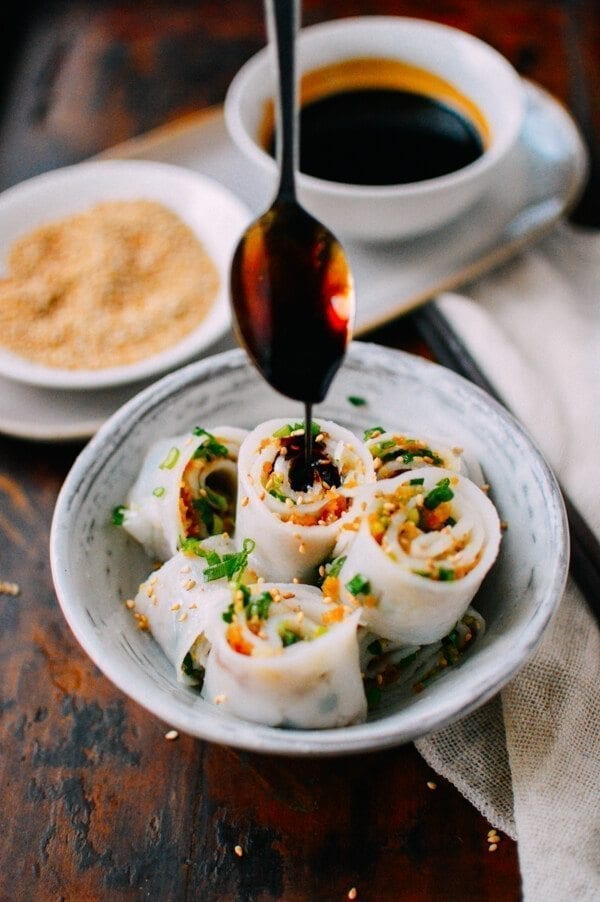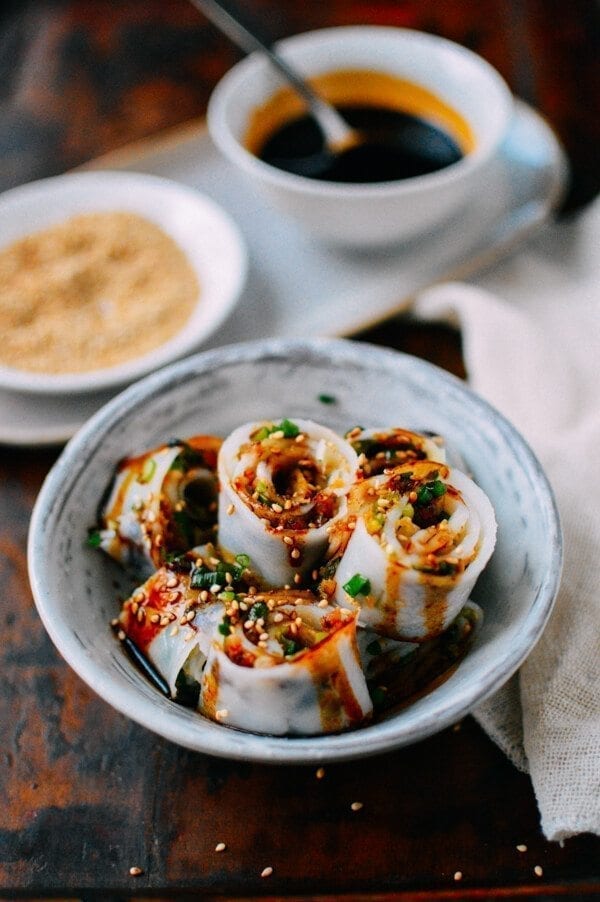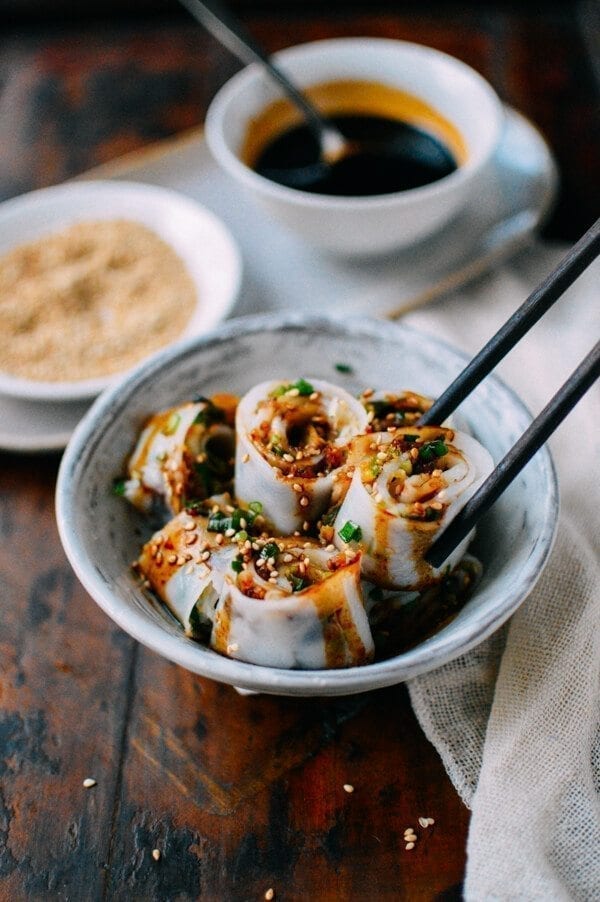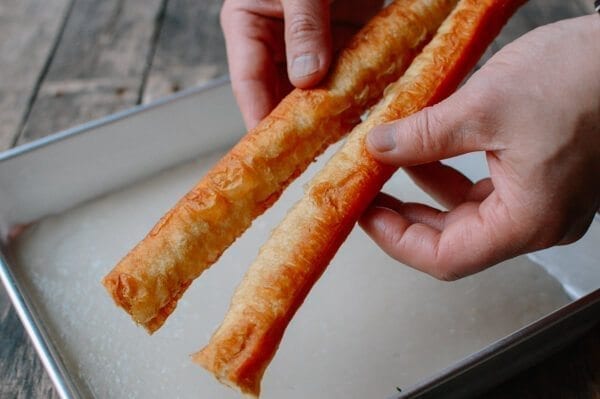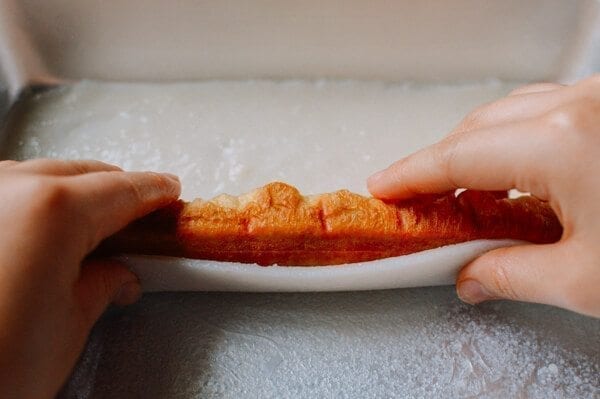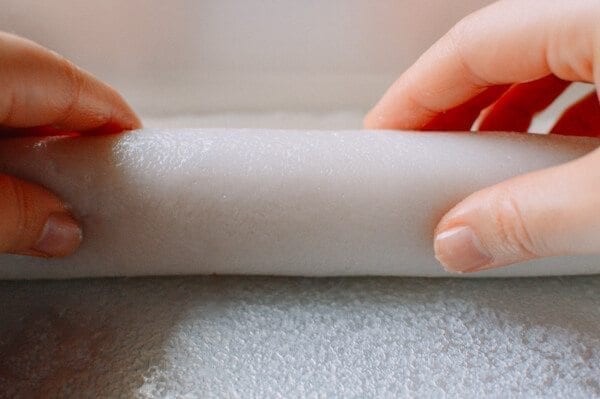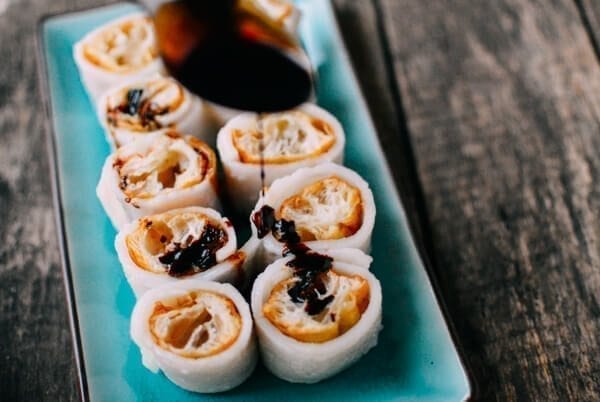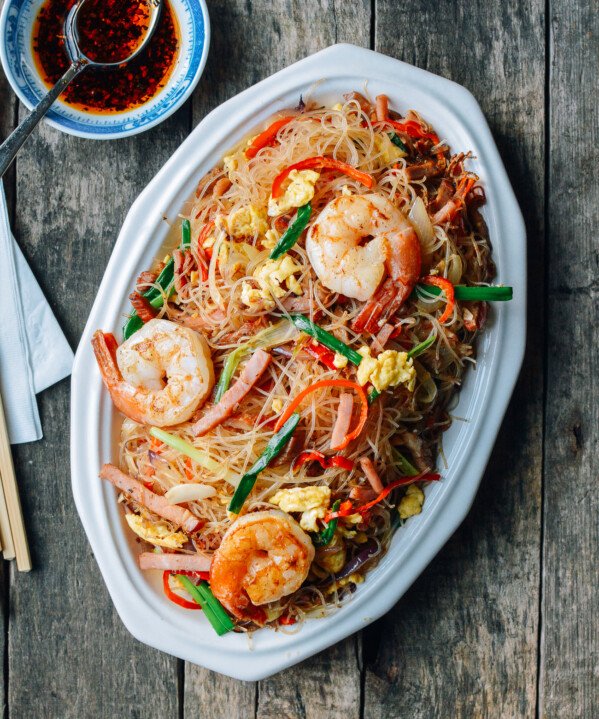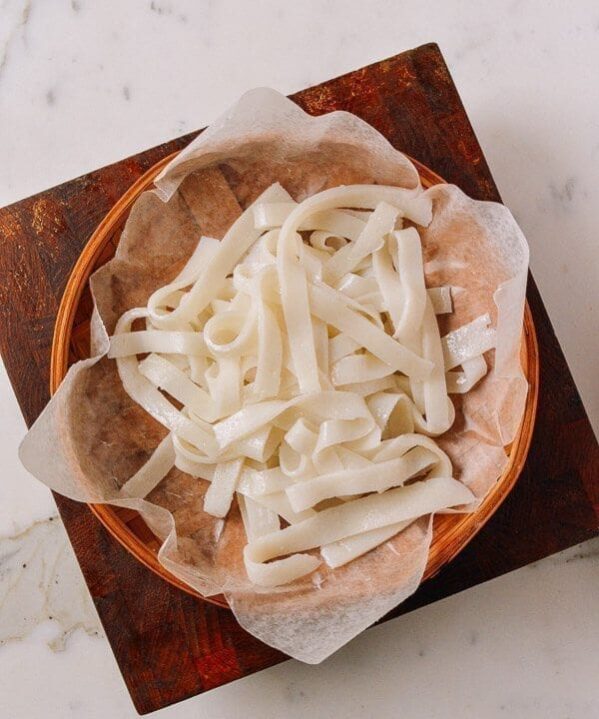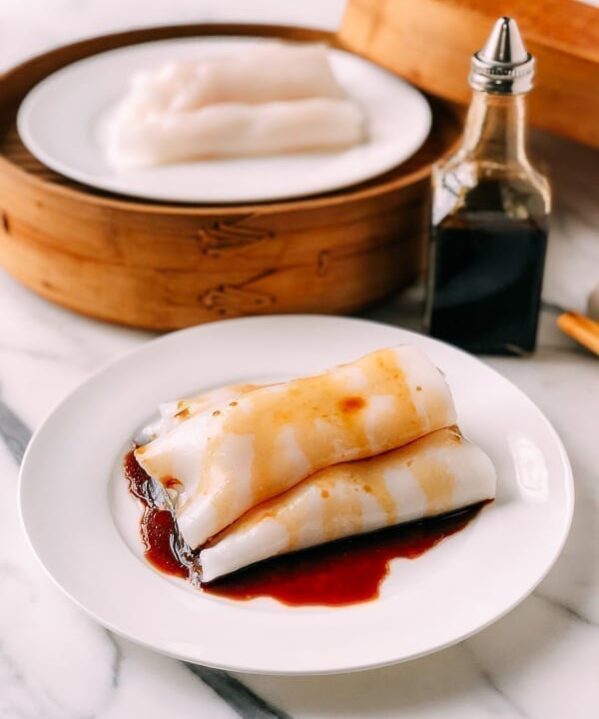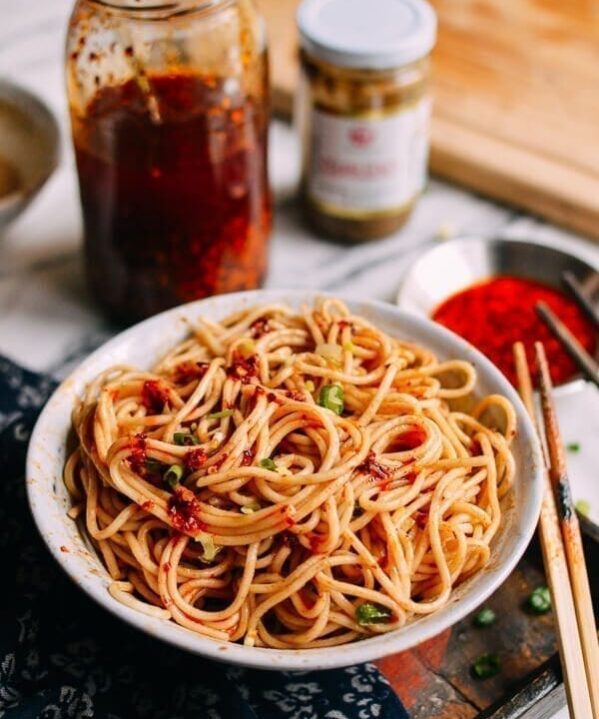We’re really excited to share this recipe for homemade rice noodles, or cheung fun, with you today. They can be used in many different applications, two of which we’re featuring right here.
The first is a classic. Dried shrimp and scallion rice noodle rolls. The second is a Chinese fried dough rice noodle roll (zha leung) which is a dim sum favorite.
These are some of my favorite dim sum dishes, not to be confused with the shrimp and beef-filled rice noodles you may also be familiar with. We’ll save those for another post!
Rice noodle sheets are not the easiest thing to make, and if you’re lucky, you can buy them made fresh daily at your Asian grocery store. If not, you can follow this recipe and make them on your own at home!
The dried shrimp and scallion rice noodle rolls bring back memories for me because it was one of the first dim sum dishes I remember eating as a kid. I used to unroll them, spread some sauce on them and then roll them back up.
These days, you can sometimes find these dried shrimp and scallion rice noodles pre-made in Asian grocery stores wrapped up in small trays with a plastic sauce cup for a quick lunch or snack. You will also see them in some dim sum restaurants.
The Chinese fried dough wrapped in rice noodles are an easy-to-make dim sum dish that I remember first seeing in dim sum restaurants as an adult. Chinese crullers (the fried dough) can usually be found near the tofu section of an Asian grocery store; they come in bags ready to be heated in the oven.
They can be eaten on their own or with this dou jiang, but when they’re wrapped in rice noodles? Fuggetaboutit (apply heavy Chinese/Brooklyn accent), so good.
Read all about the different types of Rice flour and starches in our Chinese Rice, Grains and Flours Ingredients page.
It explains the differences and show pictures of each with amazon links where you can buy and have them shipped directly to you if you don’t have a nearby Asian grocery store.
On with the recipe!
Homemade Rice Noodles (Cheung Fun) Recipe Instructions:
Makes eight 10×10” rice noodle sheets.
To make the rice noodles, combine the rice flour, tapioca starch, wheat starch, and salt in a mixing bowl. Add the canola oil and 1 1/2 cups lukewarm water and whisk until smooth. Whisk in the boiling water. Set aside and allow the batter to rest for 45 minutes.
We used an aluminum 10” square cake pan for steaming the rice noodles. You can also use a 9-inch round cake pan and simply adjust the amount of batter per batch. The noodles should be about 1/8” thick, so the batter should just cover the bottom of the pan in an even layer. This homemade noodle may come out a little thicker than what you get with dim sum in restaurants, but you can practice making them thinner!
Use a wok or a deep skillet for the steaming, but whatever you use, it must have a lid. See our post on how to set up a steamer if you’re not familiar with steaming foods in Chinese cooking.
Fill your chosen vessel with at least 2 inches of water. The cake pan with the batter in it should be able to float on the surface of the water, and then the entire cooking vessel should be able to be covered. Bring the water to a gentle simmer.
Very generously brush the bottom and sides of the cake pan with oil. Place the oiled pan on the simmering water to warm it up.
Give your batter a good stir, and then carefully pick up the pan (it’ll be hot), and pour some batter in. Swirl it around quickly so it evenly coats the bottom of the pan.
For my 10” square pan, I used a 1/3 cup of batter at a time. (Make sure that you give the batter a good stir each time before using it, because the rice flour, water and oil tend to separate a bit).
Once the pan is coated, place it on top of the simmering water, cover the pan, and steam for 3 minutes or until you see the noodle sheet bubble up in the wok which also is an indication that it is done.
For the cheung fun dipping sauce:
This dipping sauce can be served with both of these rolls.
- 2 teaspoons sugar in the raw or light brown sugar
- ½ cup water
- 2 tablespoons dark soy sauce
- 2 tablespoons oyster sauce
Add the sugar and water to a saucepan and heat until all of the sugar is fully dissolved. Add the dark soy sauce and oyster sauce and let simmer very very gently until the sauce is thin but coats the back of a spoon in a translucent layer. Set aside.
For the shrimp and scallion rice noodle rolls:
- 1/2 batch cheung fun batter
- ¼ cup dried shrimp (optional)
- 1 tablespoon oil
- ¼ teaspoon salt
- ¼ cup chopped scallions
- toasted sesame seeds
When your cheung fun batter is ready, you can start making these. In a strainer, rinse the dried shrimp (if using) under running water. Soak them in warm water for 10 minutes. Drain, and roughly chop the shrimp. Set aside.
Add oil and chopped shrimp to a small pan over medium heat, and sauté for about 2 minutes.
Add the salt and scallions, and stir until combined. Remove from the heat and set aside. If you’re not using the shrimp, simply sauté the scallions with oil and salt for 1 minute, and set aside.
Cook your rice noodle according to the instructions above and take the cake pan off the simmering water (if using store bought rice noodle sheets, simply lay the noodle out in a flat layer on a clean surface).
Spread 2 tablespoons of the shrimp and scallion mixture all over the surface of the noodle, and sprinkle some toasted sesame seeds over it as well.
Use a rubber spatula to carefully part one side of the rice noodle from the pan, and roll it up in a tight cigar.
Remove to a cutting board and slice into 1-2 inch pieces with a sharp knife dipped in warm water.
Plate and garnish with sesame seeds, scallions, and serve with your dipping sauce.
For the fried dough rice noodle rolls:
- 1 batch cheung fun batter
- 1 package Chinese crullers (try our homemade recipe)
To make this Chinese fried dough rice roll, toast 2 crullers in the oven until crispy (instructions on the package. Usually a few minutes at 350 degrees F will do the trick). Split each cruller in half, since they often come with 2 stuck together.
Take your cooked rice noodles, and roll each half of a cruller in a rice noodle sheet.
Cut into pieces and serve with your dipping sauce. (Note: the rice noodle I used for the cruller in these pictures was a little bit too thick, but you can adjust the thickness with practice and to your own personal preferences).
You may have leftover crullers but they are pretty tasty on their own!
A Cheung Fun Recipe (Homemade Rice Noodles), Two Ways
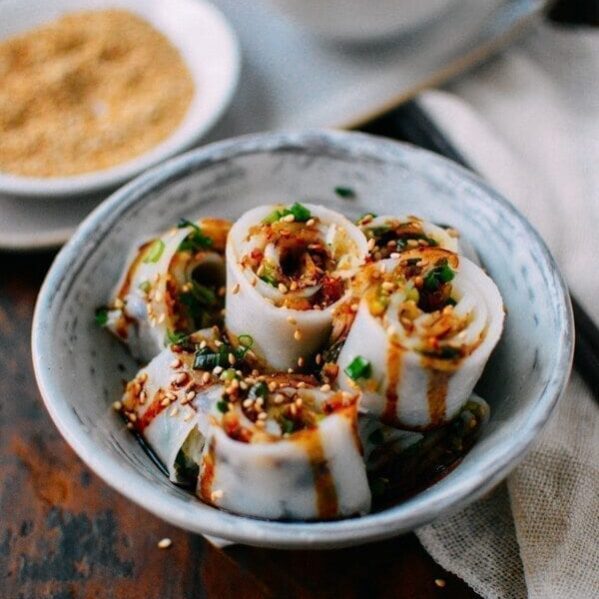
Ingredients
For the homemade rice noodles:
- 1 1/2 cups rice flour
- 3 tablespoons tapioca starch
- 2 tablespoons wheat starch
- 1/2 teaspoon salt
- 2 tablespoons canola oil (plus more for greasing the pan)
- 1 1/2 cups lukewarm water
- 1 cup boiling water
For the dipping sauce:
- 2 teaspoons light brown sugar (or raw sugar)
- ½ cup water
- 2 tablespoons dark soy sauce
- 2 tablespoons oyster sauce
For the shrimp & scallion rolls:
- 1/2 batch cheung fun batter
- ¼ cup dried shrimp (optional)
- 1 tablespoon oil
- ¼ teaspoon salt
- ¼ cup chopped scallions
- toasted sesame seeds
For the fried dough rolls:
- 1 batch cheung fun batter
- 1 package Chinese crullers (or try our homemade recipe)
Instructions
TO MAKE THE RICE NOODLES:
- Combine the rice flour, tapioca starch, wheat starch, and salt in a mixing bowl. Add the canola oil and 1 1/2 cups lukewarm water and whisk until smooth. Whisk in the boiling water. Set aside and allow the batter to rest for 45 minutes.
- We used an aluminum 10” square cake pan for steaming the rice noodles. You can also use a 9-inch round cake pan and simply adjust the amount of batter per batch. The noodles should be about 1/8” thick, so the batter should just cover the bottom of the pan in an even layer. This homemade noodle may come out a little thicker than what you get with dim sum in restaurants, but you can practice making them thinner!
- Use a wok or a deep skillet for the steaming, but whatever you use, it must have a lid. Fill your chosen vessel with at least 2 inches of water. The cake pan with the batter in it should be able to float on the surface of the water, and then the entire cooking vessel should be able to be covered. Bring the water to a gentle simmer.
- Very generously brush the bottom and sides of the cake pan with oil. Place the oiled pan on the simmering water to warm it up. Give your batter a good stir, and then carefully pick up the pan (it’ll be hot), and pour some batter in. Swirl it around quickly so it evenly coats the bottom of the pan. For my 10” square pan, I used a 1/3 cup of batter at a time. (Make sure that you give the batter a good stir each time before using it, because the rice flour and water tends to separate a bit).
- Once the pan is coated, place it on top of the simmering water, cover the pan, and steam for 3 minutes.
TO MAKE THE DIPPING SAUCE:
- Add the sugar and water to a saucepan and heat until all of the sugar is fully dissolved. Add the dark soy sauce and oyster sauce and let simmer very very gently until the sauce is thin but coats the back of a spoon in a translucent layer. Set aside.
TO MAKE THE SHRIMP & SCALLION ROLLS:
- When your cheung fun batter is ready, you can start making these. In a strainer, rinse the dried shrimp (if using) under running water. Soak them in warm water for 10 minutes. Drain, and roughly chop the shrimp. Set aside.
- Add oil and chopped shrimp to a small pan over medium heat, and sauté for about 2 minutes. Add the salt and scallions, and stir until combined. Remove from the heat and set aside. If you’re not using the shrimp, simply sauté the scallions with oil and salt for 1 minute, and set aside.
- Cook your rice noodle according to the instructions above and take the cake pan off the simmering water (if using store bought rice noodle sheets, simply lay the noodle out in a flat layer on a clean surface).
- Spread 2 tablespoons of the shrimp and scallion mixture all over the surface of the noodle, and sprinkle some toasted sesame seeds over it as well. Use a rubber spatula to carefully part one side of the rice noodle from the pan, and roll it up in a tight cigar.
- Remove to a cutting board and slice into 1-2 inch pieces with a sharp knife dipped in warm water. Plate and garnish with sesame seeds, scallions, and serve with your dipping sauce.
TO MAKE THE FRIED DOUGH ROLLS:
- To make this Chinese fried dough rice roll, toast 2 crullers in the oven until crispy (instructions on the package. Usually a few minutes at 350 degrees F will do the trick). Split each cruller in half, since they often come with 2 stuck together.
- Take your cooked rice noodles, and roll each half of a cruller in a rice noodle sheet. Cut into pieces and serve with your dipping sauce. (Note: the rice noodle I used for the cruller in these pictures was a little bit too thick, but you can adjust the thickness with practice and to your own personal preferences).
